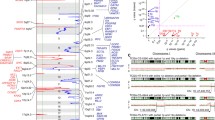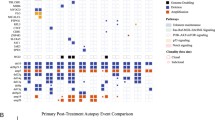Abstract
A recurrent tumor is defined as a re-emerging subclone originating from an ancestorial clone of the primary neoplasm. Hence, it should be distinguished from de novo tumor emerging from other clones. Herein, we describe an exceptional case in which the locally re-emerging glioma did not share genetic alterations of the primary tumor. While the initial tumor harbored mutations in IDH1 and TERT genes as well as 1p/19q codeletion, the re-emerging tumor did not present any of these genetic abnormalities. Variant calling for tumor samples using whole-genome sequencing revealed that 1696 mutations within the primary tumor faded in the re-emerging tumor, and that 4591 mutations were newly detected in the re-emerging tumor. These results suggested that the initial and re-emerging tumors did not share same clonal origins, although the second tumor appeared adjacent to the old surgical cavity 5 years after the initial surgery. We finally speculated that the re-emerging tumor could be a “de novo glioma” or “radiation-induced glioblastoma following treatment of a diffuse glioma.” This case highlights the importance of molecular re-evaluation of clinically diagnosed “recurrent” glioma lesions.


Similar content being viewed by others
Availability of data and materials
The anonymized datasets analyzed in the present study are provided in supplementary information. The data of molecular profiling in this paper will be made freely available upon reasonable request.
References
Cahan WG, Woodard HQ et al (1948) Sarcoma arising in irradiated bone; report of 11 cases. Cancer 1:3–29
Deng MY, Sturm D, Pfaff E et al (2021) Radiation-induced gliomas represent H3-/IDH-wild type pediatric gliomas with recurrent PDGFRA amplification and loss of CDKN2A/B. Nat Commun 12:5530
DeSisto J, Lucas JT Jr, Xu K et al (2021) Comprehensive molecular characterization of pediatric radiation-induced high-grade glioma. Nat Commun 12:5531
Feltz R, Schalldach U, Kruger J et al (2001) Malignant brain tumors after radiation—glioblastomas after operation and radiation of meningiomas—2 case reports. Zentralbl Neurochir 62:48–56
Hayashi S, Kitamura Y, Hirose Y et al (2017) Molecular-genetic and clinicopathological prognostic factors in patients with gliomas showing total 1p19q loss: gain of chromosome 19p and histological grade III negatively correlate with patient’s prognosis. J Neurooncol 132:119–126
Hayes J, Yu Y, Jalbert LE et al (2018) Genomic analysis of the origins and evolution of multicentric diffuse lower-grade gliomas. Neuro Oncol 20:632–641
Jeuken J, Cornelissen S, Boots-Sprenger S et al (2006) Multiplex ligation-dependent probe amplification: a diagnostic tool for simultaneous identification of different genetic markers in glial tumors. J Mol Diagn 8:433–443
Johnson BE, Mazor T, Hong C et al (2014) Mutational analysis reveals the origin and therapy-driven evolution of recurrent glioma. Science 343:189–193
Kawaguchi S, Kashiwaba T, Koiwa M et al (1991) Two autopsied cases of radiation-induced gliosarcoma. No Shinkei Geka 19:285–290
Kim H, Zheng S, Amini SS et al (2015) Whole-genome and multisector exome sequencing of primary and post-treatment glioblastoma reveals patterns of tumor evolution. Genome Res 25:316–327
Korshunov A, Schrimpf D, Ryzhova M et al (2017) H3-/IDH-wild type pediatric glioblastoma is comprised of molecularly and prognostically distinct subtypes with associated oncogenic drivers. Acta Neuropathol 134:507–516
Lin KC, Cheng TJ, Yung JM et al (2007) Malignant astrocytoma following radiation for nasopharyngeal carcinoma: case report and review of the literature. Acta Neurol Taiwan 16:27–32
Lombardi G, Della Puppa A, Gardiman MP et al (2018) Discordance of IDH mutational status between lesions in an adult patient with multifocal glioma. Neuro Oncol 20:1142–1143
Lopez GY, Van Ziffle J, Onodera C et al (2018) The genetic landscape of gliomas arising after therapeutic radiation. Acta Neuropathol 137:139–150
Louis DN, Perry A, Wesseling P et al (2021) The 2021 WHO Classification of Tumors of the Central Nervous System: a summary. Neuro Oncol 23:1231–1251
Mazor T, Chesnelong C, Pankov A et al (2017) Clonal expansion and epigenetic reprogramming following deletion or amplification of mutant IDH1. Proc Natl Acad Sci USA 114:10743–10748
Monje ML, Ramakrishna NR, Young G et al (2007) Durable response of a radiation-induced, high-grade cerebellar glioma to temozolomide. J Neurooncol 84:179–183
Nicolardi L, DeAngelis LM (2006) Response to chemotherapy of a radiation-induced glioblastoma multiforme. J Neurooncol 78:55–57
Okamoto N, Miya F, Tsunoda T et al (2015) Targeted next-generation sequencing in the diagnosis of neurodevelopmental disorders. Clin Genet 88:288–292
Ostrom QT, Cote DJ, Ascha M et al (2018) Adult glioma incidence and survival by race or ethnicity in the United States from 2000 to 2014. JAMA Oncol 4:1254–1262
Shia J, Tang LH, Vakiani E et al (2009) Immunohistochemistry as first-line screening for detecting colorectal cancer patients at risk for hereditary nonpolyposis colorectal cancer syndrome: a 2-antibody panel may be as predictive as a 4-antibody panel. Am J Surg Pathol 33:1639–1645
Suzuki H, Aoki K, Chiba K et al (2015) Mutational landscape and clonal architecture in grade II and III gliomas. Nat Genet 47:458–468
Tomita H, Nogaki H, Shibata Y et al (1995) Brain stem glioma induced by radiotherapy: report of a case. No Shinkei Geka 23:151–155
Umehara T, Arita H, Yoshioka E et al (2019) Distribution differences in prognostic copy number alteration profiles in IDH-wild-type glioblastoma cause survival discrepancies across cohorts. Acta Neuropathol Commun 7:99
van den Bent MJ, Brandes AA, Taphoorn MJ et al (2013) Adjuvant procarbazine, lomustine, and vincristine chemotherapy in newly diagnosed anaplastic oligodendroglioma: long-term follow-up of EORTC brain tumor group study 26951. J Clin Oncol 31:344–350
Wang J, Cazzato E, Ladewig E et al (2016) Clonal evolution of glioblastoma under therapy. Nat Genet 48:768–776
Watanabe T, Nobusawa S, Kleihues P et al (2009) IDH1 mutations are early events in the development of astrocytomas and oligodendrogliomas. Am J Pathol 174:1149–1153
Yamanaka R, Hayano A, Kanayama T (2016) Radiation-induced gliomas: a comprehensive review and meta-analysis. Neurosurg Rev 41:719–731
Acknowledgements
We would like to thank Editage (www.editage.com) for English language editing.
Funding
This investigation was supported by JSPS KAKENHI 17K16646 (T.U.), 16K20006 (H.A.) and 20K09324 (H.A.), and AMED JP21gm0810011 (Y.K.) and JP21ck0106534 (Y.K.).
Author information
Authors and Affiliations
Contributions
TU, HA, YK and HKis had major roles in the study concept and design. YF, NH and EM contributed to the clinical management of the patient and sample acquisitions. TU, TA, TS, EY, DK, and TN conducted the molecular studies. HKiy and EM conducted the pathological examination. TU, HA, FM, TS and YK contributed to analysis of data. TU, HA, FM, MK, NK, TT and YK contributed to interpretation of data. TU, HA and FM were major contributors in writing the manuscript. MK, NK, EM, TT and HKis revised the manuscript. All authors read and approved the final manuscript.
Corresponding author
Ethics declarations
Conflict of interest
The authors declare no conflict of interest.
Ethical approval
All procedures performed in studies involving human participants were in accordance with the ethical standards of the institutional and/or national research committee and with the 1964 Helsinki Declaration and its later amendments or comparable ethical standards. Genetic analysis was conducted following approval by the internal ethical review boards of Osaka University Graduate School of Medicine (approval number: 13244). Written informed consent to participation and publication was obtained from the patient.
Additional information
Publisher's Note
Springer Nature remains neutral with regard to jurisdictional claims in published maps and institutional affiliations.
Supplementary Information
Below is the link to the electronic supplementary material.
Rights and permissions
About this article
Cite this article
Umehara, T., Arita, H., Miya, F. et al. Revisiting the definition of glioma recurrence based on a phylogenetic investigation of primary and re-emerging tumor samples: a case report. Brain Tumor Pathol 39, 218–224 (2022). https://doi.org/10.1007/s10014-022-00438-1
Received:
Accepted:
Published:
Issue Date:
DOI: https://doi.org/10.1007/s10014-022-00438-1




